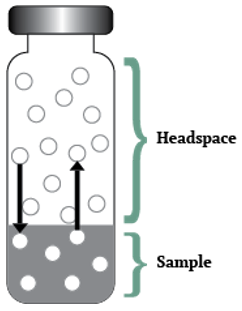Posted by Chrom Tech on 14th Oct 2025
The 3 Most Common Applications for Headspace Vials
Gas chromatography (GC) is an essential analytical technique used to separate and analyze volatile substances in complex mixtures. A specialized method known as headspace gas chromatography (HS-GC) focuses on isolating and examining specific volatile compounds without direct injection of the sample matrix. This method is ideal for detecting trace volatiles with minimal interference and high reproducibility.

To perform headspace GC, a small aliquot of the cooled sample is placed into a 10 mL or 20 mL headspace vial, sealed to withstand pressure as volatile components are released. When the sample is heated, these components vaporize into the “headspace” above the sample while non-volatile substances remain behind. The resulting gas phase is then injected into the GC for analysis, providing clear results with minimal contamination from the matrix.
Common Applications of Headspace GC
Headspace GC is widely used across pharmaceutical, forensic, and food industries due to its ability to analyze volatile compounds accurately and efficiently.
- Blood Alcohol Analysis: Used to determine ethanol concentration in blood samples, providing a direct and precise measurement alternative to breath testing.
- Residual Solvent Testing (Pharmaceuticals & Cannabis): Ensures solvents used during extraction or production meet safety and regulatory limits, protecting consumers from harmful exposure.
- Flavor & Aroma Profiling (Food Industry): Identifies volatile aromatic compounds that define taste and smell, helping manufacturers refine flavor profiles and product consistency.
Why Specialized Vials Are Required for Headspace GC
Headspace GC vials differ from standard autosampler or HPLC vials. The larger volume (10–20 mL) allows ample space for the gas phase to form and maintain equilibrium before injection. Caps must provide an airtight, pressure-resistant seal to contain volatile compounds during heating, ensuring both accuracy and safety. Chrom Tech’s headspace vials and closures are engineered to maintain integrity under GC conditions, reducing the risk of leaks and sample loss.
Crimp Caps and Chain of Custody Compliance
In forensic, environmental, and legal laboratories, maintaining sample integrity is crucial. Crimp-top headspace vials provide a tamper-evident seal, preserving sample authenticity and ensuring compliance with chain-of-custody regulations. This makes crimp vials the preferred choice for validated testing environments where data integrity and traceability are required.
For additional guidance on selecting the best vial and closure for your method, read our related post: How to Choose the Right Headspace Vial Cap, or contact our Chrom Tech sales team for personalized support.
Frequently Asked Questions About Headspace GC
What is headspace gas chromatography used for?
Headspace GC is used to analyze volatile compounds without direct contact with the liquid or solid matrix. It’s ideal for residual solvent testing, alcohol analysis, and flavor compound studies.
Why do headspace vials need to be larger than standard GC vials?
Larger vials (10 or 20 mL) create enough space for gas expansion and equilibrium during heating, ensuring accurate and reproducible headspace analysis.
How do crimp caps improve sample integrity?
Crimp-top caps provide a tamper-evident seal that prevents evaporation and contamination. They’re essential for forensic and regulatory testing where chain-of-custody must be maintained.
Where can I purchase Chrom Tech headspace vials and closures?
Chrom Tech offers high-quality headspace vials, caps, and closures designed for GC applications. Shop the full selection at chromtech.com.


